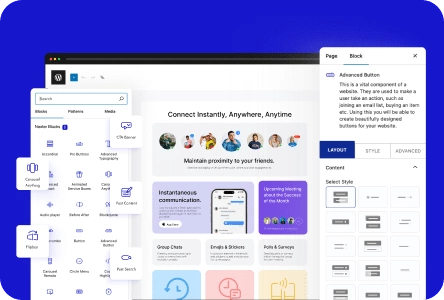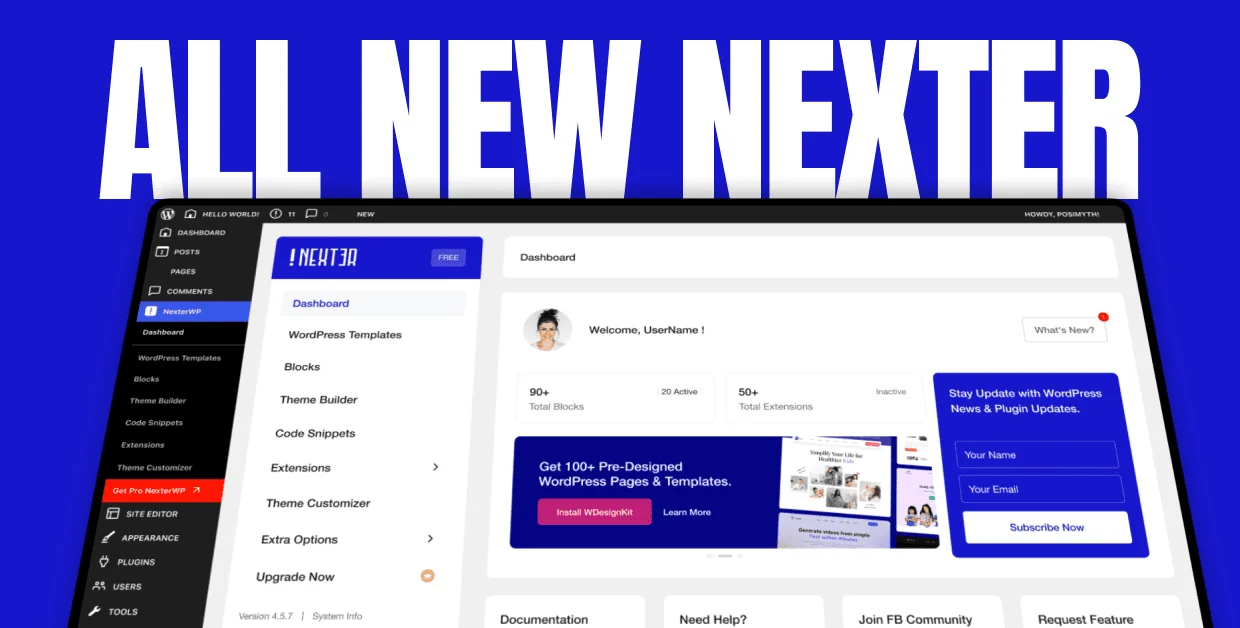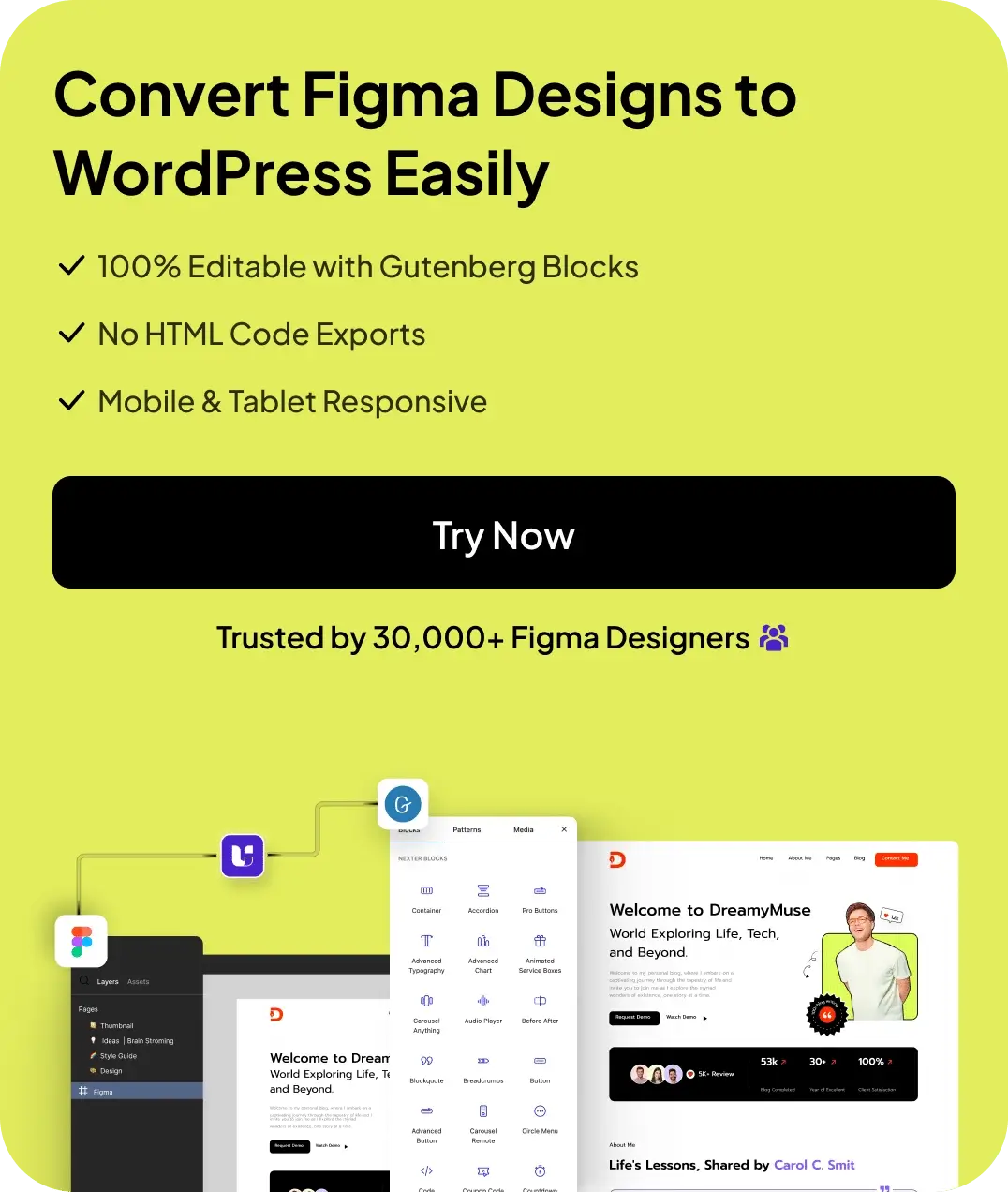Want to help your website visitors navigate and interact with your site better? Start by learning how to add a sidebar in WordPress.
A WordPress sidebar is valuable real estate on your website that offers you a chance to engage visitors and guide them through your site.
Usually, you would add a sidebar through a WordPress theme or a plugin, however, the lack of clear documentation can make this difficult.
Other methods of creating a sidebar involve custom codes, which may not be the easiest method if you aren’t an expert coder.
In this article, we explore how you can add a sidebar in WordPress using easy beginner-friendly methods.
What is a Sidebar in WordPress?
A WordPress sidebar is an area on your website where you can display information that isn’t part of your main post content.
It’s typically located on the left or right side of your pages, though sidebar location can vary depending on your theme. It’s a supplemental area for navigation menus, widgets, and other elements that you want to be accessible throughout your site.
It’s a great way to improve user experience and provide extra information.
Benefits of Adding a Sidebar to Your Website
Here are some reasons you should add a sidebar in Gutenberg:
- Helps with navigation: A sidebar can house essential navigation links, making it easy for visitors to find different sections of your website. This improves site usability and encourages visitors to explore more of your blog posts.
- More space for additional content: Sidebars provide a dedicated area for content that doesn’t fit within your main content area, such as author bios, related posts, or email signup forms. This keeps your main content focused while still offering valuable supplementary information.
- Increases user engagement: By offering readily available search boxes, social media profile links, or interesting related content, you can encourage visitors to interact more with your site. This keeps them on your site longer and improves their overall experience.
- Extra ad space: If you monetize your website, sidebars can be a great location for displaying advertisements. This can generate revenue without disrupting the user experience of your main content.
- Better content organization: Sidebars allow you to organize your website’s information more effectively. You can use a sidebar menu to categorize content, making it easier for users to find what they’re looking for, and creating a content aware experience.
Want to improve navigation with a mega menu? Here’s how to create a mega menu on WordPress.
How to Add a Sidebar in WordPress
You can use several methods to add a sidebar to your WordPress website. Here are some of the easiest methods.
Method 1: Adding a Sidebar Using a Theme
This is the simplest method, as many WordPress themes come with built-in sidebar functionality. Choosing the right theme is the first step in easily adding a sidebar.
Not all themes include sidebars. When selecting a theme, either through the WordPress theme directory or a third-party provider, carefully review its features and screenshots to ensure it includes sidebar areas. Look for terms like “sidebar,” “widget areas,” or “right/left column.” Consider browsing specifically for sidebar WordPress themes to simplify your search. Themes such as Nexter support the sidebar feature.
Once you’ve chosen a theme, install and activate it through your WordPress dashboard Appearance > Themes.
Some themes offer customization options for sidebars, such as their position and width. These options are usually found in the WordPress Customizer Appearance > Customize.
![How to Add a Sidebar in WordPress [easy Methods for Beginner] 5 Appearancee](https://nexterwp.com/wp-content/uploads/2025/02/Appearancee.webp)
Explore the Customizer settings to see if your theme offers such controls. This is where you can find options to customize WordPress sidebar appearance.
![How to Add a Sidebar in WordPress [easy Methods for Beginner] 6 WordPress sidebar](https://nexterwp.com/wp-content/uploads/2025/02/WordPress-sidebar.webp)
Go to Appearance > Widgets in your WordPress dashboard. You’ll see a list of available widgets on the left and the theme sidebars on the right. Drag and drop the widgets you want to include in your sidebar into the designated sidebar area.
![How to Add a Sidebar in WordPress [easy Methods for Beginner] 7 WordPress dashboard](https://nexterwp.com/wp-content/uploads/2025/02/WordPress-dashboard.webp)
After adding a widget, you can configure its settings. Each widget has different widget options, allowing you to customize its content, appearance, and functionality.
Wondering about which theme to use? Here are the 7 Best WordPress SEO Friendly Themes to choose from.
Method 2: Adding a Sidebar Using Widgets
Even if your theme doesn’t explicitly advertise sidebars, it might still support widget areas that function similarly.
Navigate to Appearance > Widgets in your WordPress dashboard. Look for areas on the right side of the screen. These areas, even if not labeled sidebar, might represent locations where you can add widgets. Some themes use terms like “Main Widget Area,” “Footer Widget Area,” or similar. These are essentially theme sidebars provided by your chosen theme.
Select the widgets you wish to add to your side bar from the widget menu. WordPress offers a wide range of widgets for various functionalities.
![How to Add a Sidebar in WordPress [easy Methods for Beginner] 8 Using Widgets](https://nexterwp.com/wp-content/uploads/2025/02/Using-Widgets.webp)
The Vertical Toggle menu widget from Nexter Blocks is a great addition if you wish to improve navigation on your website.
Configure each widget as needed using its individual settings and widget options.
Method 3: Using a Sidebar Plugin
If your theme doesn’t support sidebars, or you require more control over their placement and content, a sidebar plugin is the recommended approach. Here’s how to create your first custom sidebar using a plugin.
Start by installing a sidebar plugin. Navigate to Plugins > Add New in your WordPress dashboard. Search for a plugin like “Custom Sidebars” (or similar) and install it. Activate the plugin after installation.
After activating the plugin, go to Appearance > Widgets. You should see an option to “Create a New Sidebar.” Click this button.
Your newly created sidebar will now appear in the list of available widget areas. From the Available Widgets section, drag and drop the desired widgets into your new sidebar. For example, you might add a search bar, a calendar, and a navigation menu to a sidebar named “New Sidebar.”
The plugin should provide settings to control where your custom sidebar appears. This might involve selecting specific pages, posts, or categories.
Looking for a good sidebar plugin? Here are the 8 best sidebar plugins for WordPress.
Tips for Customizing Your Sidebar
Here are some best practices for custom sidebar design:
- Keep it uncluttered: Avoid overloading your sidebar with too many widgets or elements. A clean and simple sidebar is more user-friendly and effective. Focus on the most important information you want to highlight.
- Make it mobile-friendly: Ensure your sidebar adapts well to different screen sizes. A responsive design ensures a positive user experience on all devices. Test how your sidebar appears on phones and tablets.
- Use visuals sparingly: While images and icons can enhance your sidebar, use them strategically. Too many visuals can make your sidebar appear cluttered and overwhelming. Prioritize clear and concise text.
- Consider your target audience: Tailor your sidebar content to the interests and needs of your visitors. Think about what information would be most helpful to them and prioritize those elements. You can analyze your site traffic to understand what users are looking for.
Suggestions for Sidebar Content
Your sidebar offers a prime opportunity to engage your visitors and provide them with valuable resources. Consider including the following:
- Categories: Whether you run an online store or a blog, displaying product categories or a blog categories (using a category list) helps users quickly find what they’re interested in. This improves navigation and encourages exploration of your content.
- Search Bar: A readily available search box empowers visitors to find specific information on your site. This is especially useful for websites with a large amount of content, allowing users to quickly locate what they need.
- CTA Buttons and Contact Forms: Prominent call-to-action buttons encourage specific actions, like subscribing to a newsletter or downloading a resource. Integrating a contact form directly into your sidebar makes it easy for visitors to reach out with questions or inquiries, fostering communication and engagement.
- Navigation Menus: Beyond your primary menu, consider adding supplementary navigation menus to your sidebar. This can highlight key sections of your website, popular posts, or specific landing pages, improving site navigation and user experience.
- Social Media Links: Connecting your website to your social media presence is crucial. Displaying social media links in your sidebar allows visitors to easily follow you on various platforms, expanding your reach and building your online community.
Stay updated with Helpful WordPress Tips, Insider Insights, and Exclusive Updates – Subscribe now to keep up with Everything Happening on WordPress!
Wrapping Up
Sidebars provide a dedicated space to improve navigation, promote content, and engage your visitors. Whether you choose the theme, widget, or plugin method, the best approach depends on the complexity and specific needs of your sidebar.
Beyond the sidebar, you can add even more functionality to your website using the Nexter Blocks for WordPress plugin.
Nexter Blocks is a powerful WordPress plugin that supercharges your Gutenberg editor with 90+ Gutenberg blocks.
These blocks are mobile-friendly, easy to use, and incredibly intuitive, offering loads of customization options to perfectly match your website’s unique style and aesthetics.
With Nexter Blocks, you can easily create stunning layouts, add advanced functionality, and build a website that truly speaks for your brand.
FAQs on Adding the Sidebar in WordPress
Can I add multiple sidebars to my WordPress site?
Yes, you can add multiple sidebars to your WordPress site. The easiest way is, if your theme supports it, through the WordPress customizer tool. It allows you to visually configure your website, including adding and managing sidebars. If your theme doesn’t offer this, use a plugin or custom code to add a sidebar.
Do all WordPress themes support sidebars?
No, not all WordPress themes support sidebars. While many themes include sidebars as a standard feature, some, especially those with minimalist or full-width designs, may omit them. Themes like Nexter do offer the sidebar functionality. Always check the theme’s features before you install it to ensure it meets your needs.
Are sidebars responsive on mobile devices?
Whether sidebars are responsive on mobile devices depends on the theme you’re using. A well-coded, responsive theme will ensure your sidebar adapts to different screen sizes, providing a good experience for your mobile visitors. Typically, on smaller screens, the sidebar will move below the main area to maintain a clearer layout.
Can I add sidebars to WooCommerce pages?
Yes, you can add sidebars to WooCommerce pages. Many themes offer specific settings for WooCommerce pages, allowing you to control the presence and appearance of sidebars on product pages, category pages, and shop pages. You can also use a plugin or custom code to add sidebars to your WooCommerce pages.
Is it possible to create a sidebar without plugins?
Yes, creating a sidebar without plugins is possible through your theme and the widget system, accessible via the Appearance menu in your WordPress dashboard. Your theme defines the theme sidebars, designated areas where you can place content, and WordPress provides a range of widgets that you can manage within the Appearance > Widgets section.











